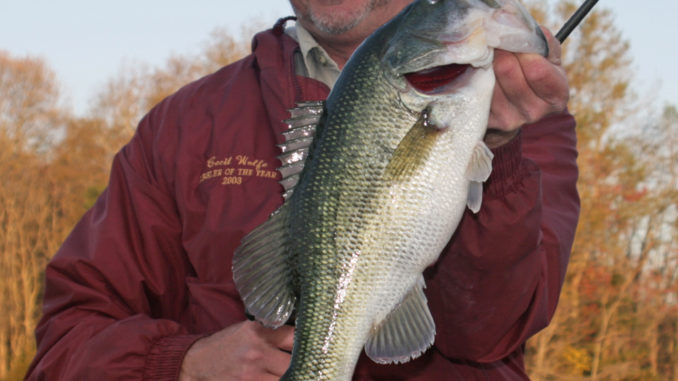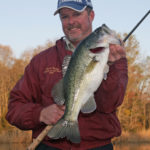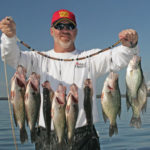
Everything in the lake is biting this month
December doldrums don’t exist at Santee Cooper in terms of good fishing opportunities. Hot action is the norm on both lakes for stripers, catfish, crappie and largemouth bass. The big question — as we learned in early October — is whether conditions such as rain and wind curtail typically great fishing in December.
Under normal weather and water conditions, December is a very predictable month at Santee Cooper, and that prediction is excellent.
According to former guide Don Drose of Manning, December striper fishing on Lake Marion ranks among the best in terms of quality and quantity of fish caught. Drose said that by December, plenty of keeper-sized stripers are concentrated in the lower end of the lake. Often, they are in the open water of the main lake, but sometimes, especially later in the month, they’ll be found in major creeks such as Wyboo. In addition to legal fish 26 inches or longer, a lot of fish that are just short of the size limit will be caught and released, but catching and releasing big numbers of 25-inch fish provides lots of enjoyment.
Drose said December offers plenty of topwater schooling action and excellent live-bait fishing. He typically begins the day watching gulls, and if he sees topwater action where gulls congregate, bucktails and topwaters are cast to the stripers. If the shad are packed in an area but the action is sub-surface, he drops live bait, including shad, shiners or herring, down to the depth fish are marked on the graph.
On Lake Moultrie, guide Leroy Suggs focuses his attention on stripers during December.
“December is an excellent month for stripers, particularly big stripers,” Suggs said. “Both the topwater and live-bait bites are good, and it’s a daily preference based on what the stripers prefer.”
Suggs (910-995-1168), who guides out of Blacks Camp, said December fishing is a bit different on Lake Moultrie because most years, huge schools of menhaden are found near the Pinopolis Dam, and they can be caught and used as bait.
“I prefer them about the size of a small bream, about three fingers wide,” Suggs said. “Menhaden are excellent striper bait, and (they) also tempt huge catfish to load on as a bonus.
“When using menhaden — or blueback herring if you can’t get menhaden — work the humps and ridges of Lake Moultrie in 10 to 50 feet of water. The fishing is often best close to the Pinopolis Dam. The productive depth will be influenced by time of day, cloud cover and wind, and the reduced-light times usually means a shallower bite. But the key is the forage. If you find the either menhaden or shad, stripers are likely close by.”
Suggs said for schooling fish, he’ll use a 1/2- or 3/4- ounce bucktail. He prefers Sea Strjper bucktails with a white head, red eyes and a white body.
“I do often use the heavier lures and allow them to drop deeper before reeling them in because the larger, keeper-sized stripers will often be beneath the surface-feeding fish,” he said.
Catfish action is wide-open at both lakes.
Guide Linwood Thornhill (843- 753-2231) said that big catfish can be targeted along with the stripers by looking for exceptionally big fish marks on the graph when fishing for stripers or catfish.
“Even when drift-fishing, I prefer to see my catfish targets on the graph,” Thornhill said. “I don’t random drift-fish. If I find catfish loaded in a general area, drift-fishing in December can be awesome. The key in every instance is being around a lot of baitfish.”
On Lake Marion the primary catfish pattern early in the month is to anchor over large schools of shad and fan-cast around the boat. During most of December catfish will be in a localized area, but not congregated tight enough to fish vertically under the boat for suspended fish. This technique begins to produce around Christmas and into January.
Crappie fishing is an overlooked fishery this month, particularly at Lake Moultrie. The deeper water of the lower lake seems to provide optimum conditions for late-season crappie.
Most fishermen will catch crappie off of underwater brush piles along the ledges and humps on Lake Moultrie and in some areas of lower Lake Marion.
The basic tactic is to move and look for crappie at a specific depth and pattern on a given day. The patterns change slightly but usually not dramatically during December unless an unusual weather event occurs. The fishing is consistent over and around deep brush along ledges and the sides of humps. Live minnows or small jigs will produce depending on personal preference and skill level. Jigs are very productive, but December crappies typically bite very lightly, and a deft touch is needed when fishing deep water. Tight-lining minnows on a long rod with a light tip will enable anyone to see even a light bite and set the hook. Sometimes, it’s simply a matter of having to search for crappie in a few different depths until you hit the right one for the day.
Largemouth bass action is very good on both lakes, according to several guides. The basic pattern is for bass to move to slightly deeper cover on edges of deep water, such as creek channels, ditches and old underwater ponds. On Lake Marion, Wyboo, Potato, Taw Caw and Eutaw creeks are all productive.
On Lake Marion, excellent targets include cypress trees adjacent to a drop or the isolated cypress trees near deeper water, docks, stumps and rocks near a drop. Best lures include crankbaits worked slowly, spinnerbaits, plastic worms and jig and grub combos. The retrieve on all shod be on slow.
Similar targets on Lake Moultrie are fished the same way; also, work the edges of grass beds with Rat-L-Traps, spinnerbaits, and twitch- or stick-type plastic worms in 4 to 10 feet of water. The rocks in the Diversion Canal hold some hefty bass during December and are caught with crankbaits and worms.







Be the first to comment